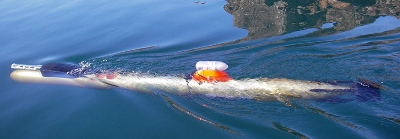Oct 18 2010
Scientists at the British Columbia University are researching the ice-shelves of Antartica between October 17 and November 12 with the help of UBC-Gavia, an Autonomous Underwater Vehicle (AUV) which will traverse through deep ice-covered waters of Antarctica’s Erebus Glacier Tongue in McMurdo Sound of thickness 100 m whose latitude is 77° south.
 UBC-Gavia UAV
UBC-Gavia UAV
The UBC-Gavia measures 2.5 x 0.5 mm and is incorporated with various sensors for detecting various parameters like temperature, light and salinity. Other features include a digital camera, mapping sonar, current meters and water quality optical sensors.
Researchers have envisaged that by 2100 the sea ice area distributed around Antarctica will be decreased by around 33%, thereby hastening the disintegration of ice shelves. It was reported that ice shelves of thickness 100m are suspended on the sea, wrapping around half of Antarctica’s seashore.
Hence the UBC scientists are researching on the impact of ice shelves on the sea-water interactions and will offer significant information for the Antarctica 2010 Glacier Tongues and Ocean Mixing Research Project. The team members of this project include researchers from United States, France, New Zealand and Canada, headed by Craig Stevens from New Zealand National Institute for Water and Atmospheric Research. Their research site is situated in New Zealand’s Ross Dependency in Antarctica.
Laval, Faculty of Applied Science, UBC has stated that the research outcomes will be so distinct due to the availability of very few global AUVs which can travel either beneath the ice or in the surrounding area of ice shelves. The UBC-Gavia will be operated by Andrew Hamilton and Alexander Forrest who are PhD students in Laval’s laboratory, Civil Engineering Department of UBC. They will premeditate the UBC-Gavia mission, fixing the navigation path of the AUV, activating the right sensor as per the requirement and will upload these instructions to the unmanned vehicle which in turn navigates and gathers information automatically and will arrive at the ice-hole upon completing the mission.